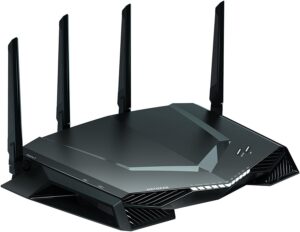Definition of Technology
What Is Technology?
Technology is the tangible and intangible practical application of proven knowledge in a given field which aims to create and improve tools, materials and processes.
Karehka Ramey
Technology is also applied in the field of science. But it is vital to know that technology and science are different subjects, rather they work hand-in-hand to accomplish specific tasks or solve problems.
The term ‘Technology” is wide, and everyone has their own way of interpreting its meaning. We use technology to accomplish various tasks in our daily lives, in brief; we can describe technology as products and processes used to simplify our daily lives. We use technology to extend mankind’s abilities, making people the most crucial part of any technological system.
We apply technology in almost everything we do in our daily lives; we use technology at work, we use technology for communication, transportation, education, manufacturing, securing data, scaling businesses and so much more. Technology is human knowledge which involves tools, materials, and systems. The application of technology typically results in products. If technology is well applied, it benefits humans, but the opposite is unfortunately true, when technology is used for malicious reasons.
Many businesses are using technology to stay competitive, they create new products and services using technology, and they also use technology to deliver those products and services to their customers on time and within budget. A good example is mobile phones companies like Apple & Samsung, these mobile empires, use high-end technology to create new smartphones and other electronic devices to stay competitive. This competitive edge is gained through employing advanced current technology.
Let’s look at a simple example of how people use technology on a daily basis.
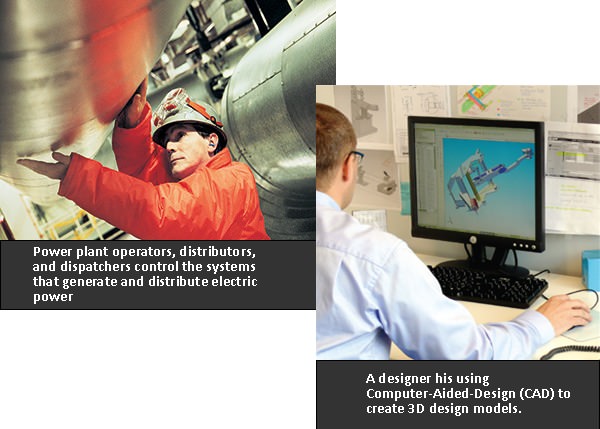
Advancing Technology
Technology is dynamic; it keeps on improving because our needs and demands for technology keep on changing. We have moved from the industrial age (industrial revolution) to an information age. During the industrial age, companies with large sums of capital had the potential of employing expensive technological tools to gain the competitive advantage; small businesses had less potential because they could not afford expensive manufacturing or processing technology tools. However, advancement in technology has created a new economic environment which depends on information, and that is what we call the ‘’INFORMATION AGE’’. The information age provides a different work environment, and this has helped small businesses gain position in highly competitive markets.
Let’s take a simple example and see how technology has advanced:
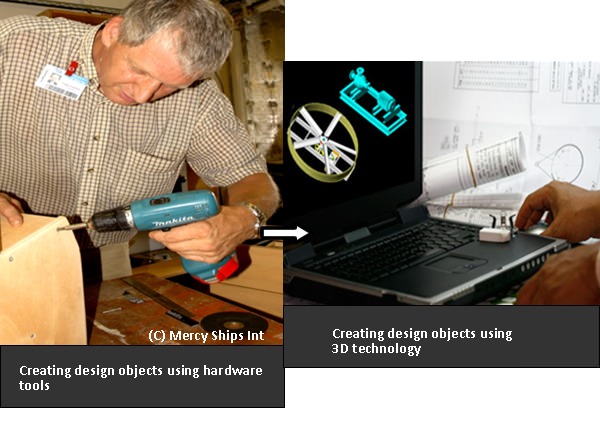
Types and Examples of Technology
We use technology to accomplish various tasks, so technology comes in different forms. Below I have listed some of the different types of technology we use on a daily basis and in each kind of technology I have included an example of that particular technology.
Communication Technology
This is a system that uses technical means to transmit information or data from one place to another or from one person to another. Communication is a daily essential for all; it is used to convey ideas, exchange information, and express emotions. Humans use communication technology tools like phones, computers, emails, fax or messaging tools to stay in touch with friends and family. Businesses use communication technology tools to facilitate the flow of information in a workplace, to help in decision making, to serve customers needs and requests, to promote new products or services to targeted consumers and so much more.
Example of Communication Technology
Plantronics M165 Marque 2 Ultralight Wireless Bluetooth Headset
This simple elegant device allows for a hands-free conversation on any mobile device, it is completely compatible with Android or IOS. It features dual microphones to reduce noise and wind interference for crystal clear call quality. Also, it boasts over 7 hours talk time.
Construction Technology
This is the study of advanced methods and equipment used to build basic and advanced structures. One type includes buildings and heavy engineering structures like bridges. Construction methods use various technological products to erect a structure. The use of construction technology tools like heavy tractors to prepare the land, computer-aided design software to create digital designs for structures in 2D and3D format. These tools along with many others help builders to efficiently complete a project on time, within budget and with minimum accidents.
Example of Construction Technology
Milwaukee M18 Fuel 2-Tool Combo Kit
Equipped with the best of Milwaukee’s technology these tools are prepared for any job you can through at it. Supported by the best brushless motors available and a powerful M18 Battery Pack.
Assistive Technology
Assistive technology is used by people with disabilities to accomplish specific tasks that are difficult or impossible to perform. The term ”Assistive” means helping or providing an extra hand. Assistive technology is being used in many ways, in schools it is used to help students with Autism to learn better, it is used to help people with disabled bodies move, additionally, with the use of speech recognition applications those who are unable to type are able to use a computer and so much more. Due to advancement in technology, we have a variety of assistive technologies that assist many to accomplish tasks that may otherwise be considered impossible.
Example of Assistive Technology
Off-road Wheelchair

Image from: www.wheelchairdriver.com
This off-road wheelchair can assist people with disabilities to move comfortably.
Medical Technology
This is the type of technology which is used to extend and improve human life. Medical technology reduces patient’s pain and cares for an injury. Developed countries have benefited from the use of medical technology in their healthcare systems, and this explains the reason why people in developed countries leave longer than people in developing countries. Medical technology is used to diagnose infections, treat diseases and to research diseases affecting humans, etc..
Example of Medical Technology
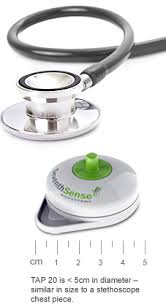
TAP 20™ for Point-of-Care Testing – SeventhSenseThis Point-of-Care Testing can help doctors obtain patient’s blood without a diagnosis. It comes with so many advantages which include:
- It’s painless for the patient.
- It keeps the blood sample until used for testing.
Information Technology
Information Technology is a set of hardware and software tools used to store, transfer and process information. Information technology tools help in providing the right people with the right information at the right time. Knowledge workers in an organization use information technology to complete various tasks, and these can include; transferring of information which facilitates decision making within an organization, improve customer service, and so much more. In this information age, it is imperative to manage information systems to ensure accuracy and efficiency. Management information systems (MIS) involves planning for, development, management, and use of information technology tools to help knowledge workers and people perform all tasks related to information processing and management. Big financial institutions like banks use information technology to operate their entire businesses as well as serve their customers.
Examples of Information Technology
NETGEAR Nighthawk Pro WiFi Router
This complete router features ultra Fast AC technology allowing for Up to 2.6Gbps of wireless speed. It houses a powerful Dual-core 1.7Ghz processor, a 4 port switch and 2 USB 3.0 slots. All you would ever need for information transfer at home.
Entertainment Technology
This use of technology to create an entertainment experience. Since entertainment is too broad, everyone gets entertained in their way. Technology is used to create video games, to develop musical systems and so much more. Entertainment technology includes things like video, sound, animations, scenery fabrication, computer simulations, interactive environments and so much more.
Example of Entertainment Technology
Numark Mixtrack 3
A DJ Console with all the bells and whistles. Everything you need to entertain!
Business Technology
This is technology used to run a business and enhance various business operations, it normally consists of a combination of software and hardware. Many businesses are using technology to scale its growth. Small businesses have used technology to create new ways of competing with well-established companies. To some extent, some business technologies can make a small company look like a big company, and this can help a small business gain position in a competitive market.
Example of Business Technology
3D Printer – Created by formlabs
This is an affordable 3D printer that allows designers to create advanced 3D objects. Its size and design are a perfect fit for every office desk space. With this 3D printer, you can create as many 3D models as you want. Use its software to generate thin, breakable support structures. Learn more about this FORM2 3D printer here.
Educational Technology
Education technology aims at improving a students performance by creating and managing various technological processes and resources in or out the classroom. It is an academic discipline which prepares individuals to acquire deeper understanding and knowledge. It helps them learn how to devise solutions to problems through research, design, evaluation, and utilization. Educational technology helps in improving the way we learn, some of the benefits of educational technology include:
- – It motivates students and encourages individual learning.
- – Easy access to educational material
- – Helps students learn new subjects and languages through gamification
Example of Education Technology
Markup:

Teachers you can try this Paperless grading application for iPad. If you want to have a paperless classroom and your students have access to iPads, then this technology will be of great use to you and your students. Markup has completely changed the way teachers mark test and exam papers; students can submit electronic papers to be marked by their teachers electronically, this saves time and resources on both sides.
What is the Difference Between Science and Technology?
Technology is not applied science, both technology and science are closely related, but they are different in so many ways.
Technology develops and explains the human-made world; it involves development, processing, and management;
While
Science explains the natural world; science refers to systematic methodology used to gather accurate information about shared reality.
During the process of gathering this information, technological tools are used. For example, microscopes are biological tools which can be used to study specific facts about anything with life.
Scientific knowledge is gathered from detached observations. Scientists can use this gathered information using technological tools to explain why certain things happen and this all process can be described as research.
As humans, we use both technology and science together, that is why we confuse these two to be the same. Science is knowledge of the natural world while technology is human-made world determined by processing, development, and management.
For you to understand the difference between science and technology, see example in figure (3) below:
Figure (3)

Look closely at the image (a), it shows you a volcanic mountain erupting, this is a natural state of our world, and it is only science which explains how this volcanic activity happens based on extensive research and data gathered by the scientist. In the image (b), we see a scientist using a microscope to do research and gather data. A microscope is a human-made technology designed to help scientists do research. So that means that both concepts work hand in hand, but they are completely different. Humans have developed various technological tools to help us solve problems during our daily lives, but also this technology can affect the natural setup of our environment if misapplied.
Advantages and Disadvantages of Technology?
Technology is good because it simplifies the way we do things in our daily lives, however, if the technology is wrongly applied, it can be harmful in so many ways. Technology is developed by humans, so we can use it to accomplish almost every task; it makes the impossible look possible. However, for you to understand the advantage and disadvantage of technology today, we can use an example in figure (4) below:
Figure (4)

As you can see in the photo above, if the technology is well implemented it can be of great use to humanity, but it can also cause harm. Below I have detailed points on the advantage and disadvantage of technology in business, classroom or education.
Advantages of Technology in Business
- Increases production: Technology helps businesses automate most tasks and this process results in increased production and efficiency. Business can automate tasks in the accounting department by using accounting software like QuickBooks. Bakeries can automate the temperature room by using temperature sensors to detect a drop or an increase in temperature.
- Technology Helps small business gain competitive advantage: If business technology is well implemented, it can help a small business gain position in a competitive market. Some of the ways small businesses use technology to scale out and gain a good position in the market are; improving customer care services through internet technologies like social networks and electronic mail, creating new products and services tailored basing on customers needs and wants
- Saves time: Since most of the activities in the business are automated, time is saved during the process. Computers can be used to perform various business tasks, for example, a computer can be used to record data, it can be used in video conferencing, and much more.
- Technology accelerates innovation: The only way small businesses can succeed in today’s competitive world is by using technology to create new products or services. Small businesses can use internet technology to collect information about targeted consumers so that they understand their needs and wants; this information can be used when tailoring new products or services.
- It improves sharing of information: Many businesses use internal networks to facilitate the flow of information within the organization. This internal network can help in the transfer of information among different departments at work. Also, employees can share different technologies like printers, fax machines, and internet via an internal network. This easy flow of information also improves the speed at which decisions are made in a business.
- It improves on data storage: It is critical to keep business data secure because a disaster can strike your business and you lose all important information. The use of databases and remote storage facilities helps in keeping business information and data secure and accessible from anywhere.
- Technology simplifies business communication: Every business survives on communication; you need to communicate with your suppliers, business partners, and employees, so technology will make this all process simple. Many businesses use communication technologies like mobile phones, video conferencing applications like Skype, text messaging services and electronic mail to exchange important business information.
Disadvantages of Technology in Business
- It’s expensive: Technology comes at a price, not every small business can manage to use technology. After buying and integrating technology in business, you will have to pay another cost of maintaining that technology, monthly maintenance is recommended, and this can be expensive.
- Not Safe: Technology is not safe; it is very easy to lose business data through internet technology. Hackers can easily access your remote database and use your business data for their own needs.
- Social/ Workplace Disconnection: Over-dependence on technology has killed workplace relationships, employees and business managers communicate through email, phones, text messages and video conferences, this kills face-face communication. Also, most tasks are being automated, so you find that employees have less involvement in the final product which leads to dissatisfaction and workplace boredom.
Advantages of Technology in the Classroom
- Technology Promotes individual learning: Students can use their iPads and internet to do personal research online and educate themselves. When a student is in control of what they learn, they will have no fear of making mistakes, and this will encourage them to explore more about a specific subject. Many teachers are allowing students to carry out personal research on particular topics; the results can be shared with other students or the entire classroom via a smart whiteboard.
- It Promotes Students engagement in the classroom: Since educational technologies like digital whiteboards are interactive, teachers can give students a chance to teach their fellow students using this interactive whiteboard. Also, the integration of Gamification technologies keeps students entertained and attentive while in the classroom because games remove that dull atmosphere in the classroom. Students can learn subjects like Math and English through playing games.
- Technology Helps students learn how to write and spell: The use of computers to take notes in the classroom has helped so many students learn how to write well-composed essays. Computers have word applications and built-in dictionaries which will auto-correct grammar mistakes while students are taking notes in the classroom. Also, teachers are encouraging students to create personal blogs so that they can practice and improve their writing and spelling skills.
- Technology Encourages group learning: The use of group sharing technologies like Piazza.com / Snagit / NoodleTools.com has helped shy students join discussion groups in the classroom without exposing their identities. Group discussions help students ask questions and learn more about a specific subject. Group discussions tend to create a strong relationship among students in the classroom, and they also help shy students learn how to socialize with others in the classroom.
- It prepares students for technical working environments: Students are taught how to use computers and various technological tools which can be of great benefit when they complete school and start applying for jobs. As the world keeps on advancing, all jobs of the future will require applicants to have some technical skills. So the use of technology in the classroom prepares students for tomorrow’s technical working conditions.
- Technology encourages risk-taking due to the challenges it presents: Technology is challenging to learn, and it presents students with puzzles to solve. During this process of solving academic puzzles, student’s brains become sharp, and they tend to get interested in taking more risks. Life is about taking risks, so if our students learn how to take risks while in the classroom, then it will be easier for them to take more calculated risks after school.
- Technology assists students with disabilities: Assistive educational technology like iPads, Robots, Games can help students with diseases like Autism learn how to speak and write. Also, deaf students can easily communicate using mobile text messaging in the classroom, and this can increase their engagement in the classroom.
- Technology bridges the gap between teachers and students: Teachers and students are using advanced educational technologies to connect more than before. New mobile text messaging technologies like www.remind101.com, can be used by teachers to remind their students about research work, remind them to prepare for a test or exam.
- Technology simplifies teachers work: Teachers have found creative ways of making their work easier by using technology in the classroom. For example, a teacher does not need to go through the hassle of marking thousands of exam/test papers, now we have a new iPad application ‘’Markup’’ which turns all students exams into electrical papers, and teachers can mark these exam papers with an iPad. This creates a paperless classroom because most students can afford computers, so exams are assigned to students electronically.
Disadvantages of Technology in the Classroom
- Distraction in the classroom: Students love to use technology in the classroom, but it tends to distract them, for example, the use of mobile phones to study in the classroom, distracts some students. Most of these smartphones have social applications like twitter, facebook, Youtube and Pinterest; students tend to use these social applications on their smartphones for entertainment purposes while in the classroom.
- It is expensive: Schools with small budgets can not afford to integrate technology into their classrooms. Also, parents with limited income can not afford to buy laptops or iPads for their children. So not every school or student will be in a position to use technology in the classroom. Then for schools which have managed to integrate technology into their classrooms, find trouble when it comes to maintaining these educational technologies.
- Requires Training: Both teachers and students need extra training on how to use various educational technologies, this can cost both time and money.
How to Solve Problems Using Technology?
Technology is designed with a purpose of solving problems; it has to meet human needs and wants. We use technology in so many ways; at least everyone uses technology in one-way or another. A problem exists when we encounter difficulty; problem-solving is human behavior, though our approach varies from person-to-person. During the process of solving a problem, the following is taken into consideration;
- Develop an understanding of the problem through observation.
- Devise a plan for solving that problem
- Implementing the plan.
- Evaluating the plan.
- Technology will be used in all those four stages of problem-solving, however, for you to easily understand how to solve problems using technology, see image example below.
Example
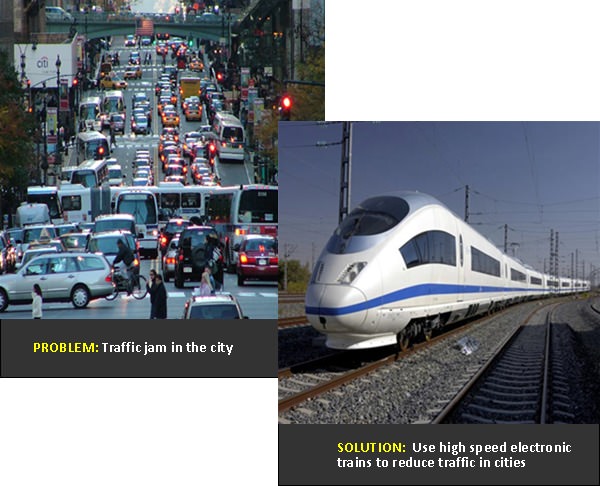
Look closely at the photo above, on the left we see the problem is the traffic jam in the city and on the right; you can see that one of the solutions of solving this traffic jam is by using high-speed electronic trains. The problem was identified, and technology was used to plan the solution and implement that solution in the city. The use of high-speed electronic trains has reduced traffic jam in big cities like Newyork. Below I have listed four basic phases you need to know about when solving problems with technology.
- Identifying a Technological Problem
During this stage, you will need to define the problem by explaining the situation that needs a technological solution and establishing the criteria that technological system or device has to meet. Then you have to gather information needed to begin developing solutions for the problem or situation.
- Developing a solution
During this phase, you will need to develop possible solutions that can solve a given problem. You will test more than one solution until you refine the best solution to solve that problem permanently and meet the opportunity.
- Evaluating the Solution
At this stage, you will be modeling the best solution through testing and evaluating all proposed solutions by use of graphics, statistics, and mathematical modeling techniques. For you to select the best technological solution, you will need to compare the design solutions regarding economic, market, technical, production, and environmental criteria to determine the best solution to that particular problem.
- Communicating the Solution
Now that you have evaluated all solutions, it is time to communicate the final solution to your team through graphical drawings, reports, and mathematical means. If you agree with your team, you can now go ahead and present the solution for approval from the management or government.
In Conclusion
Judging from the four steps of solving a problem using technology, you will see that the technology we are using started with an idea of solving a problem or meeting an opportunity. A person or a group of people saw the problem or the opportunity, and they designed solutions for meeting that problem or opportunity. Today we have various technologies which were designed to solve simple problems, for example, social networks like Facebook.com, twitter.com have solved communication and social interaction problem.
As I conclude this chapter of “WHAT IS TECHNOLOGY?” , I hope that you deeply understand the meaning of technology, types of technology being used today, the advantages and disadvantages of technology and how you can use technology to solve daily problems.




